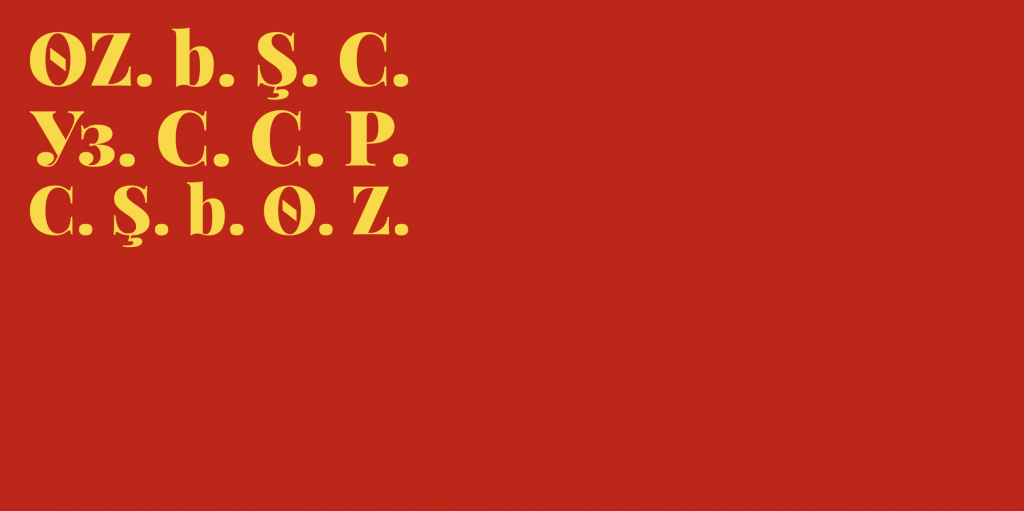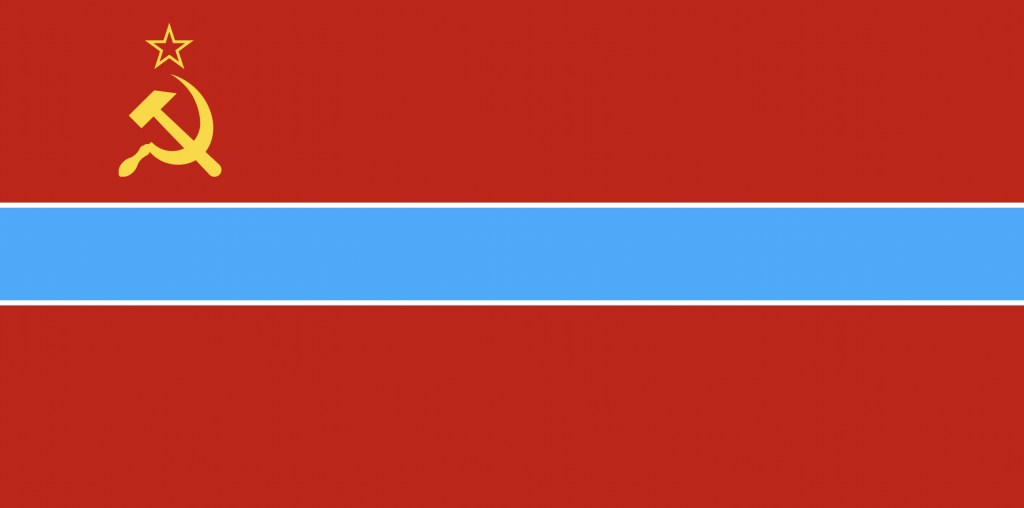Uzbekistan, which is home to nearly half the population of Central Asia, has adopted the tricolour seen in flags across the world. However, the flag of Uzbekistan incorporates distinctly Uzbek elements, such as the crescent moon with a unique twelve stars. The colour scheme of turquoise, white, and green also stands out, with thin red stripes adding a unique touch to separate the bars.

History of the Flag of Uzbekistan:
During the Soviet period, the flag of the Uzbek SSR evolved through multiple iterations reflecting changes in political priorities and cultural identity. The initial versions from 1925 and 1926 displayed the acronym “UzSSR” in Uzbek (using Arabic script) above its Russian counterpart in Cyrillic script.
In 1927, Tajik was added to the flag to acknowledge the considerable Tajik population within Uzbekistan’s borders, resulting in three scripts: Uzbek, Russian, and Tajik. This was firstly in Persian/Arabic script, then Latin. However, the inclusion of Tajik was short-lived, and it was removed all together by 1929, when much of the ethnic-Tajik part of the Uzbek SSR was reorganized into its own Tajik SSR. Subsequent years saw minor modifications to the scripts used until 1952, when a definitive design by Uzbek artist Anatoly Kuzmich Osheyko was adopted.


The final Soviet-era flag, approved on August 29, 1952, adhered to the standard Soviet aesthetic with a red background featuring the hammer and sickle, alongside the red star symbolizing the Communist Party. The flag was distinctive through its two wide horizontal red bands, interrupted by a light blue stripe flanked by two narrow white stripes.
Officially, the red symbolized the “revolutionary struggle of the working masses.” Although there was no formal explanation for the blue and white, it is widely assumed that the blue represented the Amu Darya River, a vital water source, and the white represented the cotton fields integral to Uzbekistan’s economy.
Yet as the Soviet Union disintegrated in the early 1990s, Uzbekistan was quick to establish a new identity. It became the first Central Asian republic to adopt a new national flag on November 18, 1991.
Symbolism of the Modern Flag of Uzbekistan:
The modern flag of Uzbekistan is a horizontal tricolour of blue, white, and green, separated by thin red lines, aimed to encapsulate the nation’s aspirations and cultural values.
The colours hold symbolic meanings. The blue stands for the sky and water, and is also associated with Turkic heritage, with a similar motif also seen on the Kazakh flag. White is for peace and purity, while green signifies nature, fertility, and the country’s agricultural traditions. The two thin red stripes symbolize the “life-force” and vitality of the Uzbek people. In the upper left corner, a crescent moon and 12 white stars represent the Islamic heritage, the lunar calendar, and the unity of the Uzbek people. As religious expressions were heavily restricted during the Karimov premiership (1991-2016), the crescent at that time stood for the newly-born Uzbek state, instead of any Islamic statement.
This has led to Uzbekistan having a complex relationship with its flag, especially in how it reflects the nation’s evolving identity. While it is now admitted that the crescent and stars acknowledge Islamic culture, the government has promoted secularism since independence, leading to nuanced interpretations of the flag’s symbolism.
How is the Flag of Uzbekistan used today?
The flag’s design may not be the most unique among Central Asian countries, yet it resonates deeply with Uzbeks and is omnipresent across the nation. The blue, white, and green tricolour can be seen on everything from government buildings to local businesses and even on public signage, demonstrating the country’s pride in its national emblem.
In 2010, President Islam Karimov declared the flag’s extensive public usage inappropriate, and restricted its appearance to official government purposes only. This decision temporarily curtailed the flag’s prominence in everyday settings, leading to the removal of many depictions and their replacement with more neutral symbols.
Over time, however, these restrictions loosened, and the flag of Uzbekistan has once again became a prevalent symbol. This is a testament to its significance as a icon of national pride and identity.
Today, Uzbekistan’s flag remains a potent symbol of the nation’s journey from Soviet rule to independent statehood. It reflects not only historical and cultural influences but also the aspirations of a young country striving to balance tradition with modernity. You can read more about the Uzbek flag and its symbolism on this Uzbek Government website.
Has this inspired you to visit Uzbekistan or Central Asia? For information on any of our Central Asia Tours please click here to get in touch with us, or visit our Uzbekistan landing page!





